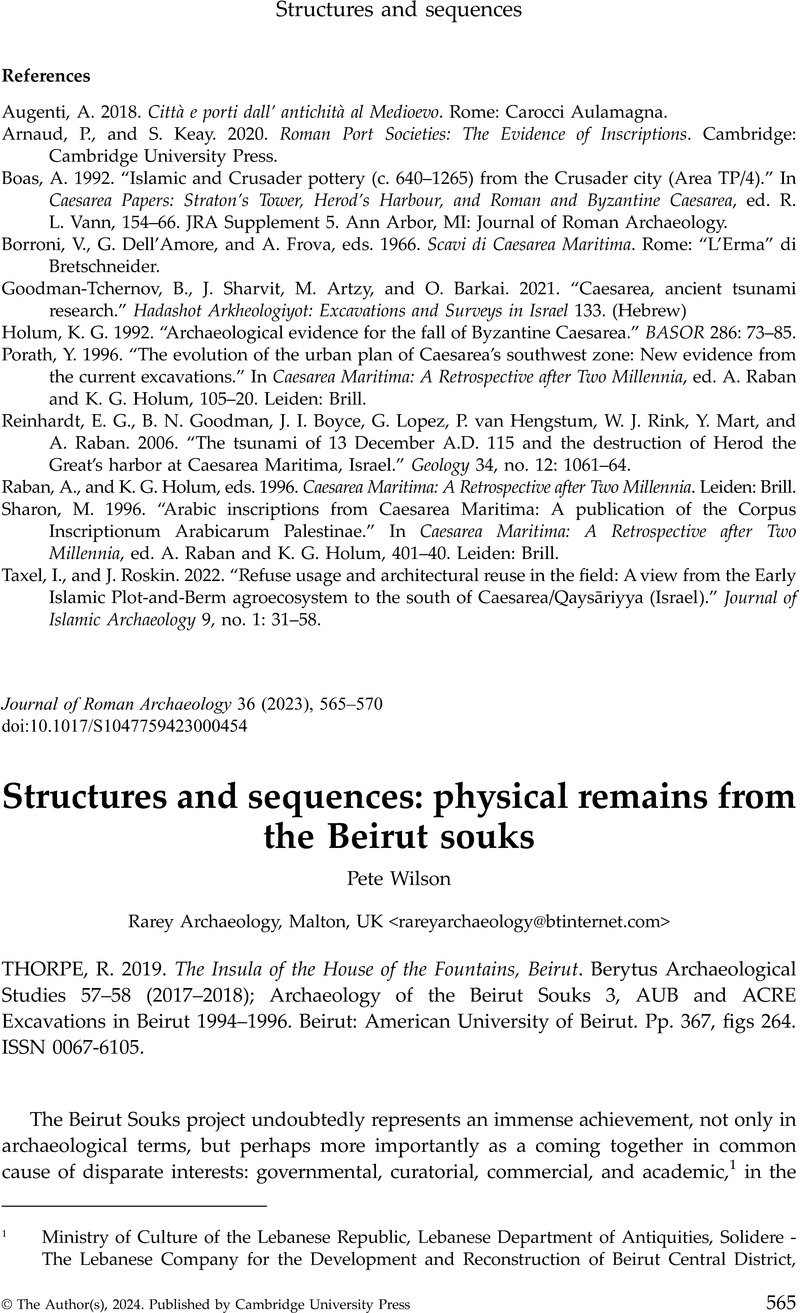No CrossRef data available.
Article contents
Structures and sequences: physical remains from the Beirut souks - R. THORPE 2019. The Insula of the House of the Fountains, Beirut. Berytus Archaeological Studies 57–58 (2017–2018); Archaeology of the Beirut Souks 3, AUB and ACRE Excavations in Beirut 1994–1996. Beirut: American University of Beirut. Pp. 367, figs 264. ISSN 0067-6105.
Review products
R. THORPE 2019. The Insula of the House of the Fountains, Beirut. Berytus Archaeological Studies 57–58 (2017–2018); Archaeology of the Beirut Souks 3, AUB and ACRE Excavations in Beirut 1994–1996. Beirut: American University of Beirut. Pp. 367, figs 264. ISSN 0067-6105.
Published online by Cambridge University Press: 09 January 2024
Abstract
An abstract is not available for this content so a preview has been provided. Please use the Get access link above for information on how to access this content.

- Type
- Book Review
- Information
- Copyright
- Copyright © The Author(s), 2024. Published by Cambridge University Press
References
Butcher, K. 2001–2002. “Small change in ancient Beirut. The coin finds from BEY 006 and 045: Persian, Hellenistic, Roman, and Byzantine periods.” Berytus 45–46.Google Scholar
Butcher, K., and Thorpe, R.. 1997. “A note on excavations in central Beirut 1994–96.” JRA 10: 291–306.Google Scholar
Curvers, H. H., and Stuart, B.. 2007. “The BCD Archaeology Project 2000–2006.” Bulletin d'Archéologie et d'Architecture Libanaises 9: 189–221.Google Scholar
Jennings, S. 2004–2005. “Vessel glass from Beirut BEY 006, 007, and 045.” Berytus 48–49.Google Scholar
Makarem, M. 1997. “Trois ans de fouilles dans le centre-ville: toujours la même polémique autour des pierres - Préservation maximale, réclament les chercheurs - Intégration harmonisée, répond Solidère (photos).” L'Orient-Le Jour, 21 January, 1997. https://www.lorientlejour.com/article/219951.Google Scholar
Millar, F. 1993. The Roman Near East 31 BC to AD 377. Harvard: Harvard University Press.Google Scholar
Mills, P. 2013. The Ancient Mediterranean Trade in Ceramic Building Materials: A Case Study in Carthage and Beirut. Oxford: Archaeopress.Google Scholar
MoLAS (= Museum of London Archaeological Service). 1994. Archaeological Site Manual. London: MoLAS.Google Scholar
Mouterde, R., and Lauffray, J.. 1952. Beyrouth, ville romaine. Beirut: Direction des Antiquities Du Liban.Google Scholar
Perring, D., with Reynolds, P. and Thorpe, R.. 2003. “The archaeology of Beirut: A report on work in the insula of the House of the Fountains.” AntJ 83: 195–229.CrossRefGoogle Scholar
Seeden, H., and Thorpe, R.. 1998. “Beirut from Ottoman landfills and sea walls to a twelfth century BC burial. Report on the archaeological excavations of the Souks northern area (BEY 007).” Berytus 43: 221–54.Google Scholar
Sheehan, P. 1997–1998. “Mosaics from BEY006: An introductory catalogue.” Berytus 43: 147–66.Google Scholar


